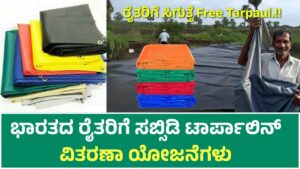Scheme : Subsidized Tarpaulin Distribution Schemes for Farmers in India
Tarpaulins, commonly referred to as tarps, are an essential agricultural tool for farmers. They serve multiple purposes, including protecting crops from adverse weather, storing harvested produce, and providing temporary shelters for farm activities. Recognizing the importance of these tools, both the Central and State Governments of India have implemented schemes to distribute tarpaulins to farmers at subsidized or discounted rates.

Purpose of the Scheme
The primary objective of subsidized tarpaulin schemes is to safeguard farmers’ crops and reduce losses due to environmental factors. Tarpaulins are particularly effective against:
- Excessive Rainfall: Heavy rains can damage crops or lead to post-harvest losses. Tarpaulins provide temporary protection for stored grains, vegetables, and fruits.
- Excessive Heat and Sunlight: Prolonged exposure to direct sunlight can negatively affect sensitive crops. Tarpaulins help create shade, protecting crops and seedlings.
- Hailstorms or Strong Winds: Lightweight tarps can shield crops from minor hail and wind damage.
- Temporary Storage and Shelter: Farmers can use tarpaulins to cover harvested produce, fertilizers, or equipment, preventing spoilage and loss.
Eligibility Criteria
To receive tarpaulins under government schemes, farmers must typically meet the following criteria:
- Farmer Registration: Applicants must be registered with the local agriculture department or possess a valid farmer ID provided by the state government.
- Land Ownership or Cultivation Rights: Some states prioritize small and marginal farmers who own or cultivate agricultural land.
- Priority for Certain Communities: In several states, Scheduled Castes (SC), Scheduled Tribes (ST), and other marginalized groups may receive additional subsidies or priority access.
- State-Specific Requirements: Eligibility criteria, including land size, crop type, or income limits, can vary by state.
Application Process
The process for availing subsidized tarpaulins generally involves the following steps:
- Visit Local Agriculture Office: Farmers can contact their district or taluk agriculture office to obtain information and application forms.
- Online Application: Some states offer online portals where farmers can apply directly for subsidized tarpaulins.
- Verification: The agriculture department verifies the farmer’s eligibility, including documents such as identity proof, farmer registration ID, and land ownership proof.
- Distribution: Upon approval, tarpaulins are provided at discounted rates, either directly through government centers or authorized dealers.
Subsidy Details
The subsidy provided for tarpaulins varies by state and scheme. Typically:
- Subsidy Range: Farmers may receive a subsidy covering 25%–50% of the tarpaulin cost.
- Discounts for Special Groups: Scheduled Caste or Scheduled Tribe farmers often get additional discounts.
- Pricing Example: A tarpaulin priced at ₹1,000 may be available to eligible farmers for ₹500 after subsidy.
Benefits to Farmers
These schemes provide several advantages to farmers:
- Financial Relief: Subsidized prices reduce the cost burden on farmers, making protective equipment more accessible.
- Crop Protection: Tarpaulins help prevent crop losses due to unpredictable weather, thereby enhancing farm productivity.
- Improved Post-Harvest Storage: By providing temporary storage solutions, tarpaulins reduce wastage of harvested produce.
- Encouraging Sustainable Agriculture: By protecting crops from environmental risks, these schemes support long-term agricultural sustainability.
State-Wise Tarpaulin Subsidy Initiatives
Various states have implemented their own versions of tarpaulin subsidy schemes. For example:
- Karnataka: Provides tarpaulins at 50% subsidized rates to small and marginal farmers. Special provisions exist for Scheduled Tribe farmers.
- Maharashtra: Offers tarpaulins under the State Agriculture Support Program to protect horticultural crops.
- Tamil Nadu: Provides tarpaulins at discounted rates through the Department of Agriculture for post-harvest storage.
- Rajasthan: Focuses on arid and semi-arid regions, giving priority to farmers growing vegetables and fruits requiring shade protection.
Conclusion
Subsidized tarpaulin distribution schemes play a crucial role in supporting Indian farmers by reducing crop losses and providing affordable protective materials. Farmers interested in these schemes should contact their local agriculture department to verify eligibility and learn about the application process. Such initiatives not only enhance productivity but also contribute to the overall resilience of the agricultural sector against environmental challenges.
